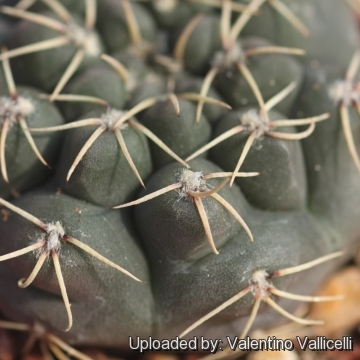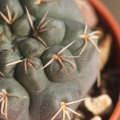




Your support is critical to our success.
Cact. Succ. J. (Los Angeles) 74(1): 4 (-9; figs. 1-13). 2002 [1 Feb 2002]
Family: CACTACEAE

Origin and Habitat: Gymnocalycium robustumSN|25919]]SN|25919]] is a highly endemic Argentinian species, where it occurs in northern Córdoba and southern Santiago del Estero (extent of occurrence is 3,500 km2)
Altitude: 300-600(-750) meters above sea level.
Type locality: Dept. Ischilín: near the village of Quilino, Córdoba (Argentina).
Habitat and Ecology: The species grows on a series of low hills and ridges comprising crumbling granitic rock, in chaco forest. The species is locally abundant and there are no major threats.
Synonyms:
- Gymnocalycium robustum R.Kiesling, O.Ferrari & D.Metzing
Description: Gymnocalycium robustumSN|25919]]SN|25919]], as the name states, is a robust, rugged cactus species characterized by thick ribs and round podaria (tubercles) with few short spines and thick receptacles and fruits. Previously, it was circulated under the name Gymnocalycium cordobensis.
Habit: Gymnocalycium robustumSN|25919]]SN|25919]] is a slowly growing succulent species, usually solitary.
Root: It has a central, robust, obconical rootstock about 5 cm long and up to 2 cm in cross-section.
Stem: Spherical or hemispherical depressed at apex, 3-5 cm tall and 8-11 cm in diameter grey or greyish-green with a touch of mauve.
Ribs: 9-11 straight very flat, blunt, 15 mm high, 20-35 mm wide divided into 3-5 low, rounded tubercles (up to 5 mm tall), with transverse furrow and with chin-like protrusions (podaria) beneath each areola.
Areoles: Elliptical, approx 6 x 3 mm wide, with white tomentum.
Spines: 5-7 stiff, up to 15 mm long. One of them pointing downward, the other irregularly protruding sideways. In the dry state, the spines are white as chalk, if wetted they become yellowish with brown part at the base.
Central spines: Absent.
Flowers: 2-3 at any one time near centre of plant, wide funnel-shaped, up to 6 cm (rarely to 7 cm) long and up to 6 cm broad, white with a pink throat. Receptacle funnel-shaped, up to 45 mm long, 8 to 14 mm in diameter, scales almost semicircular, wider than longer 4 mm long, 6 cm wide, succulent, grey or with a touch of red. Pericarpel more or less conical, up to 30 mm long, 5-8 mm in diameter. Ovary conical, up to 20 mm cm long, 5 mm in diameter. Pistil cylindrical, white with small bump, very short, up to 13 mm long, 2 mm in diameter. Stigma with 8-9 (- 14) lobes, bright yellow, up to 3 cm long. Nectar chamber pink, 4 mm long. Stamens, erect, parallel, filaments white, shorter than the stigma up to 11 mm long, anthers yellow 2 mm long and 1 mm wide. Inner perianth segments white, pink at the base, narrowly lanceolate, acute. Outer segments like the scales, but longer and translucent .
Fruit: Club-shaped or rarely spindle-shaped grey, pruinose, 40-45 mm long and 15-18 mm in diameter.
Seeds: Round-truncated, symmetrical, 1,2 mm long and strong, black, with cuticle usually completely separate from the testa and it will then appear as brown, much wrinkled. Hilum-micropilar area oval, 0,9 mm long, 0,6 mm wide.
Bibliography: Major references and further lectures
1) Demaio, P. & Trevisson, M. 2013. Gymnocalycium robustum. In: IUCN 2013. "IUCN Red List of Threatened Species." Version 2013.2. <www.iucnredlist.org>. Downloaded on 01 January 2014.
2) Edward F. Anderson “Das große Kakteen-Lexikon.” Eugen Ulmer KG, Stuttgart 2005
3) Cactus and Succulent Journal. Volume 74, Number 1, Los Angeles, pages 4–8. 2002

Gymnocalycium robustum Photo by: Valentino Vallicelli
The gallery now contains thousands of pictures, however it is possible to do even more. We are, of course, seeking photos of species not yet shown in the gallery but not only that, we are also looking for better pictures than those already present. Read More...
Cultivation and Propagation: Gymnocalycium robustumSN|25919]]SN|25919]] is a summer grower species that is easy to cultivate.
Growth rate: It is a relatively slow growing and easily flowering species that will make clumps given the best conditions.
Soils: It likes very porous standard cactus mix soil. Prefer a low pH compost, avoid substrata rich in limestone; otherwise growth will stop altogether.
Repotting: This plant needs plenty of space for its roots, repotting should be done every other year or when the it has outgrown its pot. Use pot with good drainage.
Watering: Needs moderate to copious waterings in summer, but do not overwater (Rot prone), keep dry in winter at a minimum temperature of 0°C.
Fertilization: Feed with a high potassium fertilizer in summer.
Hardiness: Reputedly resistant to frost if kept on the dry side prior to, and during, cold weather (hardy to -5 C ° C, or less for short periods).
Exposition: The plant tolerates extremely bright situations but enjoys filtered sunlight or afternoon shade, inside it needs bright light, and some direct sun. Tends to bronze in strong light, which encourages flowering and heavy spine production, but is likely to suffer from sun scorch or stunted growth if over exposed to direct sunlight during the hottest part of the day in summer. In full sun turns an uneven brownish red colour.
Uses: It is an excellent plant for container growing. It always looks good and stays small. It look fine in a cold greenhouse and frame or outdoor in a rockery.
Pests & diseases: It may be attractive to a variety of insects, but plants in good condition should be nearly pest-free, particularly if they are grown in a mineral potting-mix, with good exposure and ventilation. Nonetheless, there are several pests to watch for:
- Red spiders: Red spiders may be effectively rubbed up by watering the plants from above.
- Mealy bugs: Mealy bugs occasionally develop aerial into the new growth among the wool with disfiguring results, but the worst types develop underground on the roots and are invisible except by their effects.
- Scales: Scales are rarely a problem.
- Rot: This species is particularly easy and accommodating, seldom suffer of cryptogamic diseases. Rot it is only a minor problem with gymnocalyciums if the plants are watered and “aired” correctly. If they are not, fungicides won't help all that much.
Propagation: Direct sow after last frost. Seeds germinate in 7-14 days at 21-27° C in spring, remove gradually the glass cover as soon the plants will be well rooted (ca 1-2 weeks) and keep ventilated, no full sun for young plants!
| Your Actions | |
|---|---|
| Back to Gymnocalycium index | |
| Back to Cactaceae index | |
 |
Back to Cacti Encyclopedia index |
Privacy stantement - Terms and conditions - How to cite - About us - Feedback - Donate




